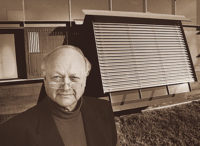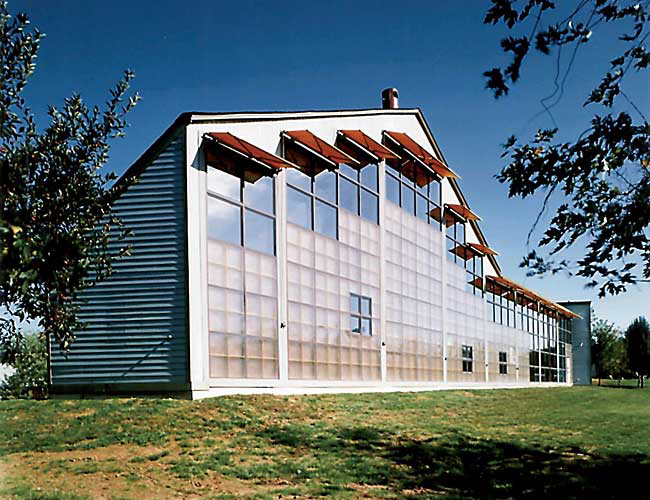Gold Medal: Peter Bohlin
Unlike recent Gold Medalists, Peter Bohlin is not a lone prodigy; his contribution is inseparable from the firm he founded 45 years ago. His work lacks grandiosity, favoring instead a light touch, a Modernism mellowed by emotion. From the start, his designs have flowed from the circumstances of each project and his attempts to be environmentally responsible.
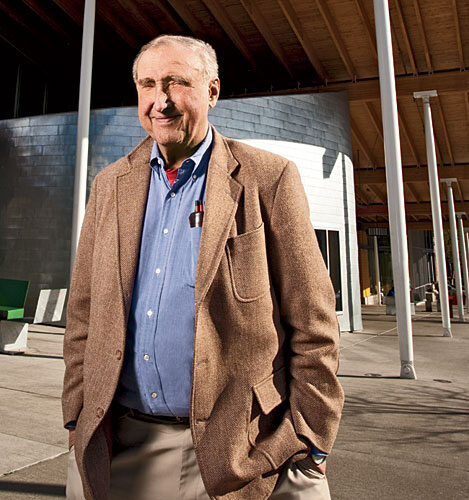
Gold Medal: Peter Bohlin
Photo © Brian Smale
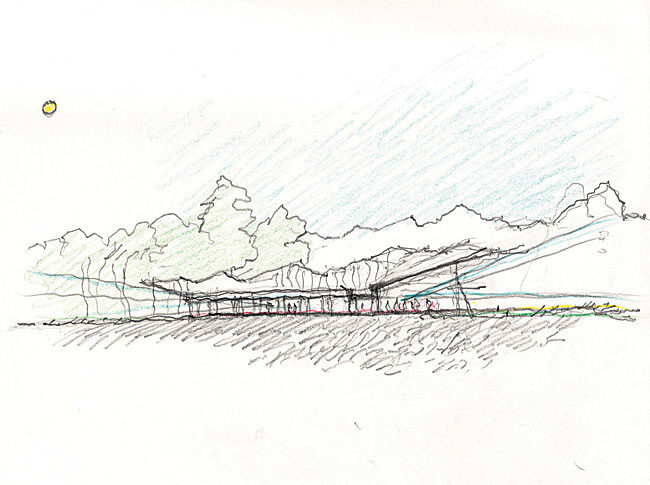
Gold Medal: Peter Bohlin
Bohlin’s sketch for the Grand Teton Discovery and Visitor Center shows circulation and the roof opening to mountain views.
Image courtesy Peter Bohlin
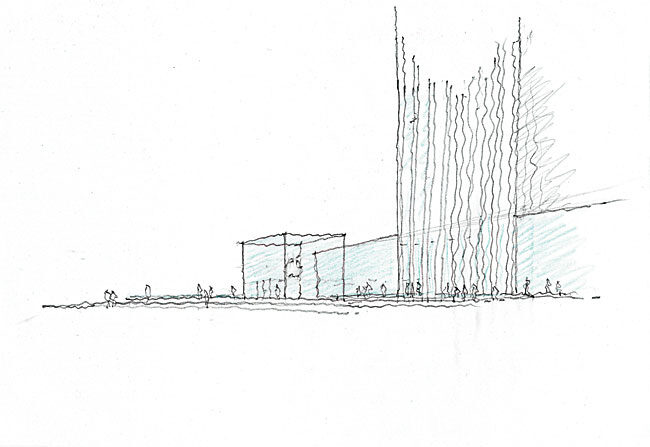
Gold Medal: Peter Bohlin
Bohlin’s early conceptual drawing for Apple Fifth Avenue envisions the 32-foot glass cube that acts both as entrance and symbol for the store.
Image courtesy Peter Bohlin
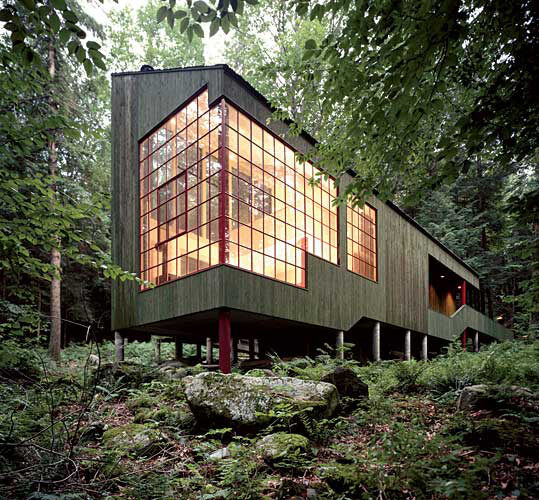
Gold Medal: Peter Bohlin
Bohlin designed this narrow, green-stained wood house as a retreat for his parents. At the junction of a dark evergreen forest and a deciduous woodland, the building springs from a log-loading platform and floats over the forest floor. Carving around an existing boulder, explains Bohlin, the house demonstrates the value of accommodation and of ""doing this and that rather than just one thing."" The architect says the house is ""all about moving from dark to light"" and points to its circulation, which originates on the shaded edge and ends in a tall, illuminated space. Bohlin’s light touch continues inside, where pale gray walls contrast with red-painted mullions that frame leafy views.
Photo © Michael Thomas
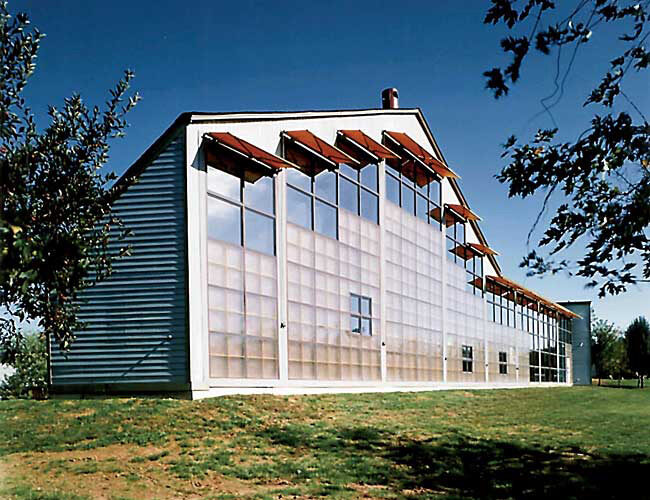
Gold Medal: Peter Bohlin
Designed and built under a federal nonresidential passive-solar demonstration program, the Girl Scout Center derives about half its heating, lighting, and hot water from solar energy. The deceptively simple design features a south-facing solar wall, an unusually thin Trombe wall supported by timber framing and brick infill. The Trombe wall facilitates quick warming on chilly mornings and distributes heat during afternoon and early evening hours when the building is in use. A concrete floor and semicircular brick wall also capture solar heat. Bohlin says that most passive-solar buildings of the time were visual one-liners. ""We wanted to make this a place children could learn from — and one that was fun.
Photo © Otto Baitz/Esto
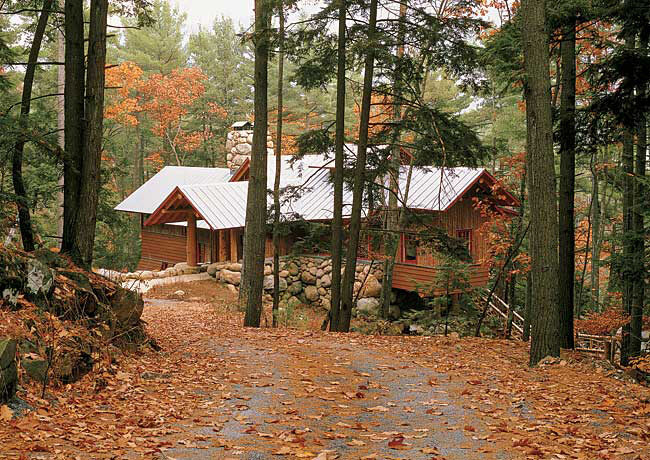
Gold Medal: Peter Bohlin
The client asked for a vacation home in the tradition of the great Adirondack camps, a request that Bohlin saw as an opportunity to enrich his Modern design vocabulary. The building steps down a steep slope at the edge of a mountain lake, adopting the design idiom of the Alpine tradition and melding man-made and natural elements. The slightly angled main entrance on the upper level inclines toward the visitor and is topped by a gable of stout logs. The entry leads through thick cedar columns to a massive granite fireplace, which rises through the structure and dominates the central living spaces, which are illuminated by high clerestories.
Photo © Karl A. Backus
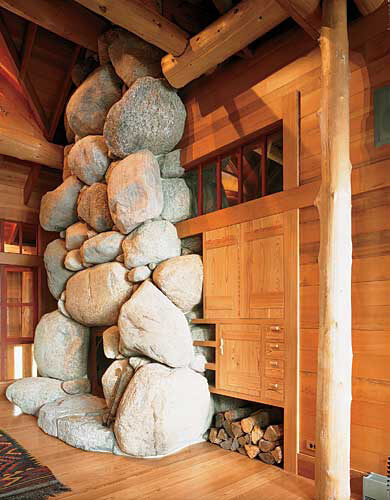
Gold Medal: Peter Bohlin
The client asked for a vacation home in the tradition of the great Adirondack camps, a request that Bohlin saw as an opportunity to enrich his Modern design vocabulary. The building steps down a steep slope at the edge of a mountain lake, adopting the design idiom of the Alpine tradition and melding man-made and natural elements. The slightly angled main entrance on the upper level inclines toward the visitor and is topped by a gable of stout logs. The entry leads through thick cedar columns to a massive granite fireplace, which rises through the structure and dominates the central living spaces, which are illuminated by high clerestories.
Photo © Karl A. Backus
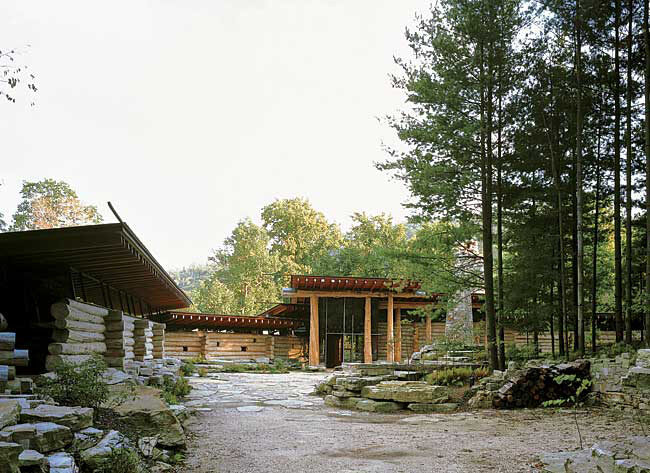
Gold Medal: Peter Bohlin
Sited on a mountainside clearing with stone ledges, Ledge House overlooks a valley. It employs the Adirondack Retreat’s material palette but represents a conceptual shift. The architects used boulders for the foundation and fireplace and logs for the entry vestibule and superstructure, and arranged timber-and-stone shed-roof pavilions in a horseshoe pattern wrapping a rock-lined entry court. The log entrance facade has a number of openings for viewing out, recalling the “gun-port” windows of the Civil War log forts that once dotted Maryland’s mountainsides. Inside, timber columns and beams, industrial metal strapping, and exposed wood joists reinforce the fortlike quality.
Photo © Karl A. Backus
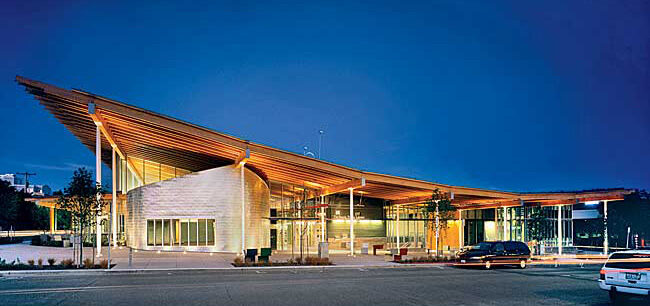
Gold Medal: Peter Bohlin
Local Residents pushed an aggressive environmental agenda and participated in selecting BCJ for this neighborhood center. In appearance, the library is at once Modern and respectful of the Ballard community’s maritime tradition. A dramatically sweeping roof supported by laminated wood beams extends beyond the exterior walls, defining the building. Both inside and out, white steel columns, tapered at each end, resemble ships’ masts.
Photo © Nic Lehoux
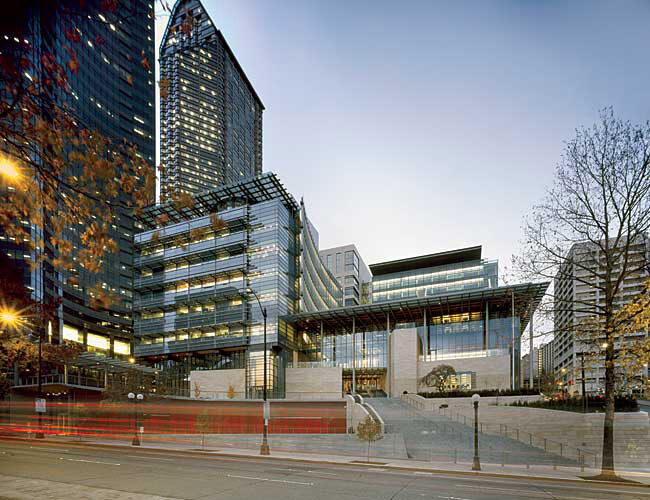
Gold Medal: Peter Bohlin
Aiming for LEED Silver, BCJ earned Gold for its Seattle City Hall. The firm’s strategies included a range of shading schemes, light shelves to distribute daylight inside, and a green roof. The city posited three requirements: City Hall had to be open and welcoming, environmentally respectful, and last 100 years. Outer walls of glass carry daylight into interiors and express the ideal of open government, while the lobby serves as a town square. The building, which glows at night, has become a civic focus for the downtown area.
Photo © Nic Lehoux
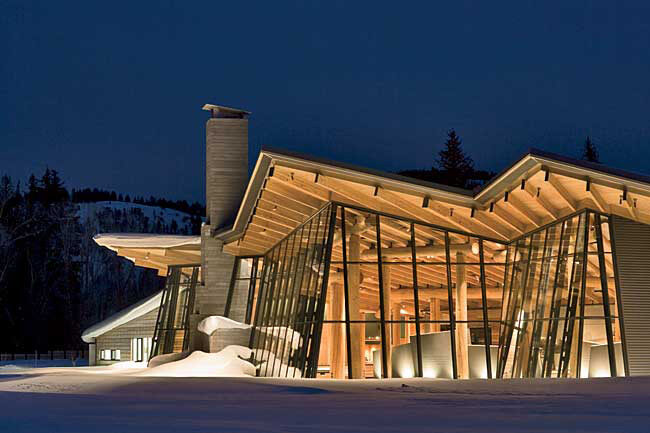
Gold Medal: Peter Bohlin
The architects successfully lobbied to separate the building and parking lot for this project, arguing that people need a short walk to decompress from the stresses of the road. BCJ designed the center to enhance, rather than compete with, the mountain views. As visitors follow a winding path from the lot, however, the Tetons temporarily disappear behind an undulating roofline that echoes the natural topography beyond. A courtyard formed by the building’s arms funnels visitors to a low entry that opens to the primary interior space with a soaring ceiling and a nearly 30-foot-high glass curtain wall facing the breathtaking views.
Photo © Nic Lehoux
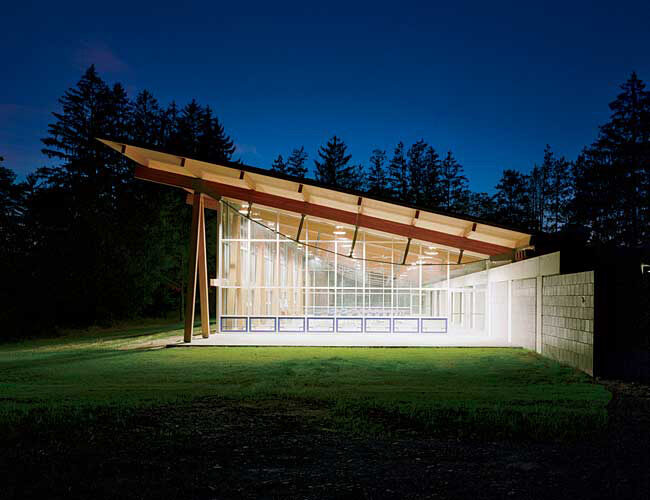
Gold Medal: Peter Bohlin
BCJ designed the Environmental Education center to reflect the commitment to environmental stewardship of its sponsors, the Pocono Environmental Education Center and the National Park Service. The building, which is used for meetings, lectures, and educational purposes, distills BCJ’s approach to nature-center design. It employs basic shed massing, a broad overhanging roof, a shingled facade made of recycled tires, natural materials, passive solar heating, natural ventilation, and daylighting strategies. The design is layered: Before entering an opening in the dark north wall, visitors traverse a forest, cross a wetland, and pass through service spaces. The entry leads into a bright, daylit central room, which is warmed by the sun, cooled by prevailing breezes, and open to views of the forest to the south.
Photo © Christopher Barone
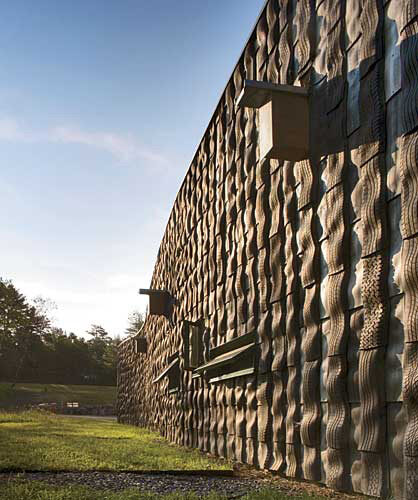
Gold Medal: Peter Bohlin
BCJ designed the Environmental Education center to reflect the commitment to environmental stewardship of its sponsors, the Pocono Environmental Education Center and the National Park Service. The building, which is used for meetings, lectures, and educational purposes, distills BCJ’s approach to nature-center design. It employs basic shed massing, a broad overhanging roof, a shingled facade made of recycled tires, natural materials, passive solar heating, natural ventilation, and daylighting strategies. The design is layered: Before entering an opening in the dark north wall, visitors traverse a forest, cross a wetland, and pass through service spaces. The entry leads into a bright, daylit central room, which is warmed by the sun, cooled by prevailing breezes, and open to views of the forest to the south.
Photo © Nic Lehoux
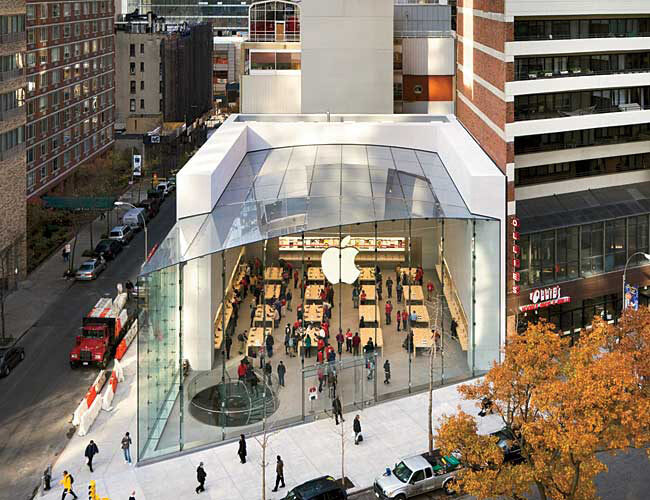
Gold Medal: Peter Bohlin
Apple has commissioned BCJ to design several stores, among them the flagship Apple Fifth Avenue (right) and Apple Upper West Side (below). Apple Fifth Avenue, the company’s busiest store, is a precision-engineered transparent cube. Mullion-free glass walls rise 32 feet to meet an all-glass roof with an almost invisible joint. The roof, of fritted insulating-glass panels on thin metal purlins, seamlessly incorporates lighting, sprinklers, and security systems. A spiral glass staircase effectively draws shoppers from the cube down to the store. Blonde maple floors, blocky wood display tables, and modular ceilings create a recognizable image for the brand. For their latest store on the Upper West Side, the architects carried over some of the same language, creating a grand, glassed-in main floor with a glass spiral staircase leading to more products below ground.
Photo © Peter Aaron/Esto
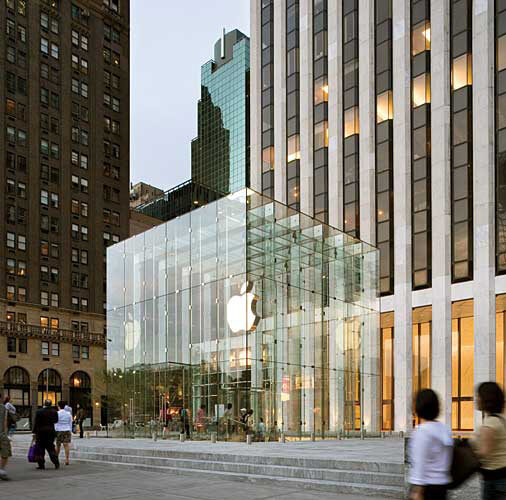
Gold Medal: Peter Bohlin
Apple has commissioned BCJ to design several stores, among them the flagship Apple Fifth Avenue (right) and Apple Upper West Side (below). Apple Fifth Avenue, the company’s busiest store, is a precision-engineered transparent cube. Mullion-free glass walls rise 32 feet to meet an all-glass roof with an almost invisible joint. The roof, of fritted insulating-glass panels on thin metal purlins, seamlessly incorporates lighting, sprinklers, and security systems. A spiral glass staircase effectively draws shoppers from the cube down to the store. Blonde maple floors, blocky wood display tables, and modular ceilings create a recognizable image for the brand. For their latest store on the Upper West Side, the architects carried over some of the same language, creating a grand, glassed-in main floor with a glass spiral staircase leading to more products below ground.
Photo © Peter Aaron/Esto
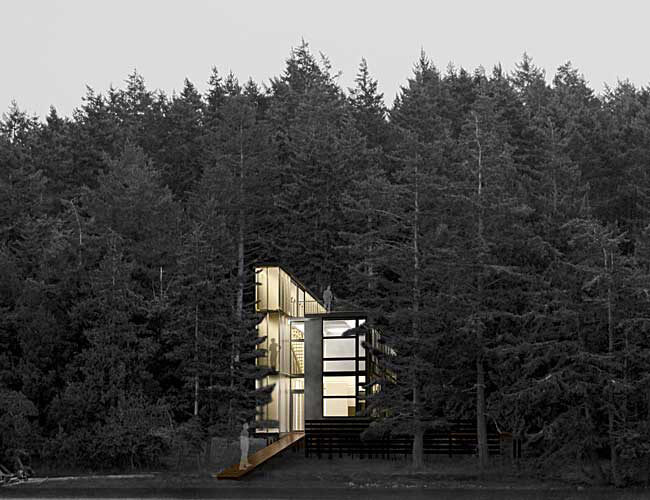
Gold Medal: Peter Bohlin
This house and studio for an architectural photographer sits on a densely forested spit of land extending south of the Canadian border and west of Washington’s coastline. To reduce the 1,200-foot structure’s footprint and its impact on the landscape, BCJ arranged it on three levels and raised it on piers. The architects are also using prefabricated building elements to prevent the damage caused by on-site construction. To build in the most economical fashion, they are spacing stock dimensional lumber 5 feet on center, accommodating 5-by-8-foot window modules. The cladding combines solid fiber cement, translucent polycarbonate, and clear glass in ways that maximize lighting schemes.
Image courtesy Bohlin Cywinski Jackson

Gold Medal: Peter Bohlin
BCJ partnered with Arup and Peter Walker and Partners in this competition-winning design for a building and landscape symbolizing the community of Newport Beach. The project consists of a new City Hall and a parking structure screened by a plant-covered wall, an expanded library, and a public park. To create the new park, the team restructured the narrow 17-acre site, restoring wetlands. City Hall’s overhanging roof, patterned like ocean swells, screens north-facing clerestories that will bring diffused daylight into each two-level bay. The council chamber will ""fly"" a shimmering fabric ""sail,"" created by a scrim of Teflon-coated mesh over a steel frame. The designers situated the chamber and interior public space near City Hall’s main entry. Light-filled, flexible work areas will be built from a standard kit of parts, and cantilevered decks along the east facade, overlooking the community and its shoreline, will provide additional outdoor meeting space.
Image courtesy Bohlin Cywinski Jackson
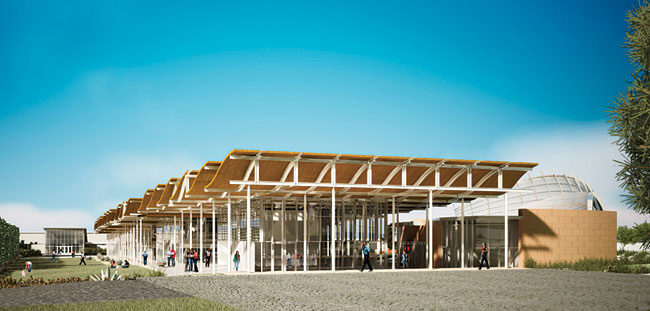
Gold Medal: Peter Bohlin
BCJ partnered with Arup and Peter Walker and Partners in this competition-winning design for a building and landscape symbolizing the community of Newport Beach. The project consists of a new City Hall and a parking structure screened by a plant-covered wall, an expanded library, and a public park. To create the new park, the team restructured the narrow 17-acre site, restoring wetlands. City Hall’s overhanging roof, patterned like ocean swells, screens north-facing clerestories that will bring diffused daylight into each two-level bay. The council chamber will ""fly"" a shimmering fabric ""sail,"" created by a scrim of Teflon-coated mesh over a steel frame. The designers situated the chamber and interior public space near City Hall’s main entry. Light-filled, flexible work areas will be built from a standard kit of parts, and cantilevered decks along the east facade, overlooking the community and its shoreline, will provide additional outdoor meeting space.
Image courtesy Bohlin Cywinski Jackson

Gold Medal: Peter Bohlin
The redevelopment of this busy West Coast port features a long, narrow border-crossing structure paralleling the U.S.-Canadian boundary and an existing treeline. To create a design that represents democracy but is secure, BCJ has unobtrusively integrated security measures into the design. The 37-by-784-foot, two-story building floats on piers over the landscape, and slotted openings, admitting vehicular and pedestrian traffic, visually connect the two countries. Inside, a light-filled lobby leads to a court and to a park whose focus is the Peace Arch Monument. The compound, a GSA Design Excellence project, will qualify for LEED Gold.
Image courtesy Bohlin Cywinski Jackson





















